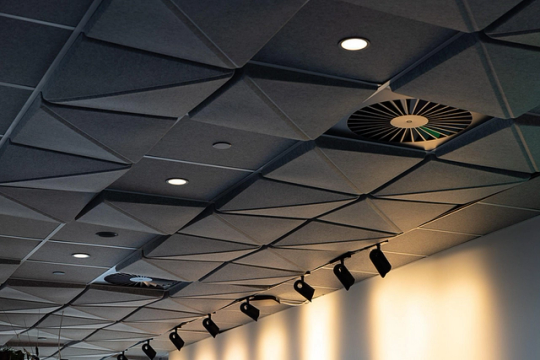#CeilingDesignTrends
Explore tagged Tumblr posts
Text
Acoustic Ceiling Tiles Market Trends Driven by Design Innovation and Sustainable Construction Demand
The acoustic ceiling tiles market trends continue to evolve in response to the growing need for better indoor acoustics, energy efficiency, and visually appealing environments. These tiles, long favored for their ability to absorb sound and reduce noise levels, are increasingly being integrated into modern construction projects due to their aesthetic versatility and eco-friendly properties. The global market is witnessing significant developments, particularly in commercial spaces, where functionality meets design in creative ways.

Growing Demand in Commercial Infrastructure
The commercial segment remains one of the largest contributors to the growth of the acoustic ceiling tiles market. Offices, educational institutions, hospitals, and retail centers all demand effective noise control solutions that don’t compromise on design. As open-plan layouts become more common in modern office architecture, the need for efficient sound absorption has increased. Acoustic ceiling tiles offer an ideal solution, allowing designers to create spaces that are both functional and comfortable.
Furthermore, the post-pandemic emphasis on wellness in the workplace has led companies to reconsider how noise affects productivity and employee well-being. As a result, more developers are incorporating acoustic ceiling tiles into both new constructions and renovations.
Aesthetic and Design Innovation Fueling Adoption
Gone are the days when acoustic ceiling tiles were limited to basic, white square panels. Modern manufacturers are focusing on delivering tiles in various colors, textures, and patterns to match contemporary interior aesthetics. These new designs cater to architects and interior designers looking for materials that contribute to visual harmony while serving a practical purpose.
3D printed textures, wood-like finishes, and customizable patterns have expanded the creative potential of acoustic ceiling tiles. This innovation is especially appealing in high-end commercial spaces like luxury retail stores, boutique hotels, and corporate offices where ambiance plays a vital role.
Sustainability and Eco-Friendly Materials
One of the prominent acoustic ceiling tiles market trends is the shift toward environmentally sustainable materials. Manufacturers are increasingly using recycled content and low-VOC (volatile organic compound) materials to meet green building certifications and appeal to eco-conscious clients. As global awareness of environmental concerns grows, the demand for sustainable construction materials has surged.
Green building codes and certifications like LEED have also driven the market toward eco-friendly acoustic solutions. Tiles made from biodegradable, recyclable, or rapidly renewable resources are becoming more prevalent, offering both performance and a smaller environmental footprint.
Technological Advancements and Smart Integration
Technology is playing an important role in reshaping the future of acoustic ceiling systems. Some manufacturers are now integrating lighting, air purification, and even smart sensors within ceiling tiles. This multifunctional approach helps maximize ceiling space usage, reduces installation complexity, and enhances the functionality of the interiors.
For example, integrated lighting solutions within acoustic tiles eliminate the need for separate fixtures, creating a clean, modern look. Additionally, smart sensors embedded within tiles can monitor temperature, air quality, and occupancy, making them ideal for intelligent building designs.
Rising Demand in Residential Spaces
While traditionally associated with commercial buildings, acoustic ceiling tiles are slowly making their way into residential interiors. Homeowners, especially in urban areas, are becoming more aware of the importance of soundproofing. Apartments, home offices, and entertainment rooms are being designed with better acoustic control in mind, pushing demand for more stylish and effective solutions.
As home renovation projects gain popularity, especially post-pandemic, homeowners are exploring advanced options for enhancing comfort. Acoustic tiles offer a balance between function and fashion, fitting seamlessly into modern interior themes.
Regional Growth and Emerging Markets
Geographically, North America and Europe remain the dominant markets, driven by advanced infrastructure and greater awareness of building acoustics. However, emerging economies in Asia-Pacific and the Middle East are showing promising growth potential. Urbanization, rising disposable income, and increased focus on quality living and working spaces are major contributing factors in these regions.
The rise of commercial construction projects, smart city developments, and infrastructure upgrades are fueling demand in these emerging markets. Local manufacturers and global brands are both investing heavily to establish a stronger presence in these regions.
Challenges and Future Outlook
Despite the optimistic outlook, the market faces a few challenges. Price sensitivity in developing markets, fluctuations in raw material costs, and installation complexities in retrofit projects can hinder growth. However, continued innovation in design, functionality, and eco-friendliness is expected to overcome these hurdles.
The future of the acoustic ceiling tiles market is firmly tied to trends in construction, design, and technology. As consumer preferences shift toward sustainable, multifunctional, and visually appealing interiors, acoustic tiles are expected to remain a core component of modern building solutions.
In summary, the market is experiencing a period of rapid innovation, driven by the need for better sound management, environmental responsibility, and integrated design. With ongoing investments in R&D and a broader range of applications, the acoustic ceiling tiles industry is poised for steady expansion across global markets.
#AcousticCeilingTiles#CeilingDesignTrends#SoundproofingSolutions#InteriorDesignInnovation#SustainableConstruction
0 notes